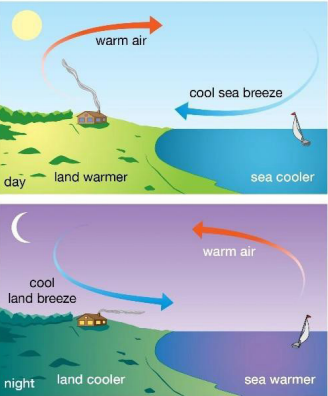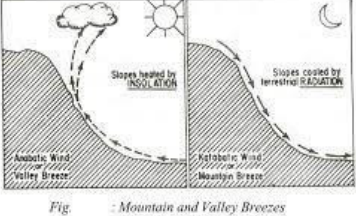
Local winds, with their dancing rhythms and unique personalities, paint their brushstrokes on the weathered canvas of diverse regions. Born not from global atmospheric patterns, but from the intimate tango between local topography and temperature differences, these winds whisper stories of their origin at mountain peaks, whisper secrets of their dance over sun-baked plains, and murmur tales of their cooling breath from vast oceans. Though ephemeral and confined to smaller scales, their influence weaves threads of significance into the prevailing weather and climate, adding unique hues to the tapestry of each region. From the warm Foehn winds sculpting valleys in the Alps to the cool, mist-laden Williwaws howling through Patagonian fjords, each local wind plays a vital role in shaping the weather and climate of its home, making their understanding vital for appreciating the rich tapestry of our planet’s atmosphere.
Contents
Answer
Local winds are winds that are influenced by specific geographic features and occur at a relatively small spatial scale, typically on a regional or local level. These winds are driven by local temperature and pressure variations, and they often exhibit daily or seasonal patterns.
The key factors influencing origin of local winds include:

1. Temperature Differences
- For E.g., Land and sea breezes, During the day, land heats up faster than water, causing air to rise over the land and draw in cooler air from the sea.
- At night, the process reverses.
2. Local Pressure Gradients
- For example, High-pressure areas over cooler regions and low-pressure areas over warmer regions can create local winds, like the Santa Ana winds in Southern California.

3. Topography
- For E.g., Mountain and valley breezes, During the day, mountains heat up faster than valleys, leading to upslope winds.
- At night, the reverse occurs with downslope winds.

4. Urban Heat Islands as drivers for local winds
- For E.g., Cities can generate their own local winds due to the heat absorbed and reradiated by buildings and pavement, influencing wind patterns.
5. Vegetation Influence
- For example, Forests can create local winds. For instance, the cool air descending from a forested area into a valley, is known as katabatic winds.
The significance of local winds in shaping the prevailing weather and climate in various regions is as follows:
- Temperature Regulation
- Local winds contribute to temperature regulation by redistributing heat, influencing daily or seasonal temperature variations.
- For e.g., Chinook Winds also called the Snow eater (Rocky Mountains, North America)
- Warm, moist air from the Pacific is lifted over the mountains, and as it descends on the leeward side, it warms up rapidly.
- Chinook winds can result in a sudden and significant increase in temperature, melting snow and thus help in early sowing of the spring wheat and influence the local ecosystems.
- Moisture Transport
- Coastal breezes can transport moisture inland, affecting precipitation patterns in coastal regions.

Case Study: California Coastal Climate

During summer months, prevailing wind direction along the California coast, from the cool Pacific Ocean towards the warmer inland areas, result of the temperature difference between the warm interior and the cooler coastal waters, moist air from the ocean moves inland, encounters coastal mountain ranges, including the Coast Ranges and the Sierra Nevada. Result: Moist air forced to ascend as it reaches mountainous barriers (orographic lifting) eventually leading to precipitation.
- Agricultural Impact
- Understanding local winds is crucial for agriculture as they affect factors like temperature, humidity, and frost occurrence.
- For e.g., Mistral (Southern France)
- High-pressure over the European continent leads to cold winds flowing southward through the Rhône Valley.
- The Mistral is a cold, dry wind that can affect agriculture and local weather patterns, sometime causing frost damage to crops.
- Air Quality
- Local winds influence the dispersion of pollutants, impacting air quality in urban areas.
- For e.g., Monsoon winds disperses the pollutants from Indian cities making air quality improve a little.
- Navigation
- Sailors historically used knowledge of local winds, such as trade winds, for navigation.
- For e.g., Bora Winds (Adriatic Sea)
- High-pressure in the interior of the Balkan Peninsula results in cold, dense air rushing towards the Adriatic Sea.
- Bora winds can be strong and gusty, impacting maritime activities particularly navigation and causing abrupt changes in weather conditions.
Understanding these local winds is essential for predicting weather patterns, managing natural resources. However contemporary climate change is causing extreme temperature and weather events leading to high climatic unpredictability in such a scenario National Action Plan on Climate Change (NAPCC), National Mission for a Green India (GIM), Atal Mission for Rejuvenation and Urban Transformation (AMRUT), FAME India Scheme are steps in the right direction.
In case you still have your doubts, contact us on 9811333901.
For UPSC Prelims Resources, Click here
For Daily Updates and Study Material:
Join our Telegram Channel – Edukemy for IAS
- 1. Learn through Videos – here
- 2. Be Exam Ready by Practicing Daily MCQs – here
- 3. Daily Newsletter – Get all your Current Affairs Covered – here
- 4. Mains Answer Writing Practice – here

